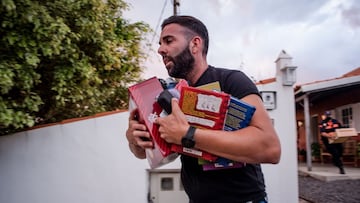Hundreds more evacuated as lava from Canary Island volcano nears the sea
The erupting volcano on the Spanish Canary Islands has forced several more residents to evacuate their homes, which stand in the path of the gushing lava.

When lava started spewing from the Cumbre Vieja volcano on Sunday, the evacuation of the municipality of El Paso began. Since then, four more villages have had mandatory evacuations and over 6,000 people have left the island in a rush, escaping the lava which has destroyed hundreds of homes already.
The damage done to La Palma
By Tuesday, the lava flow had reached the town of Todoque at about 200 meters per hour (0.07 mph). Emergency workers granted residents a two-hour window to salvage any of their belongings and families raced to save what they could. A family of three in the town of Los Llanos de Adriane rushed to load up a Toyota van with a fridge, washing machine, mattresses, and clothing.
The disaster is much more catastrophic than originally thought, causing more damage as the days go on. It was originally thought that the lava would reach the sea by Monday, but as of today (Wednesday morning), it is still slowly making its way. "The lava on its path to the sea has been a bit capricious and has diverted from its course," El Paso's mayor Sergio Rodriguez said.
Four earthquakes have occurred since the new eruption vent was opened. When the lava does finally reach the sea, there is concern from local officials that the mix of extremely hot lava with the cold salt water will cause a chemical reaction that causes explosions and releases toxic gases. An exclusion zone of two nautical miles has been set up around where the lava is heading and residents have been advised to stay away from the area, which is blocked off by police now. Regional leader Angel Victor Torres said they were powerless to stop the lava’s “inexorable” advances to the sea.
Ana Guadalupe González, an evacuee, told Spanish public radio, “we are very worried because we don’t know when we will return home.” She said feared her home would soon be engulfed by the lava so she ran out in a hurry and left many personal belongings. A primary school in Los Campitos has been destroyed completely by the lava, according to Spanish TV. The director of the school has said that at least half of the school’s 23 children and their families had lost their homes.
Currently, no casualties have been reported. The damage, however, is catastrophic. According to the EU’s Copernicus service, the lava has covered an estimated 103 hectares (1 square km) and destroyed at least 166 houses, and El Paso mayor Sergio Rodríguez has said that as many as 300 homes had been destroyed.
When will it end?
The last time the Cumbre Vieja volcano erupted was 50 years ago in 1971. Right now, scientists can’t say for sure how long this eruption will go on, but past eruptions have lasted between 24 and 84 days, according to a spokesperson for Spain’s National Geographic Institute. Involcan, the Canary Islands Volcanology Institute said the Cumbre Vieja eruption is expected to last around 55 days.
The eruption has emitted between 7,997 and 10,665 tons of SO2 (sulphur dioxide) into the atmosphere each day, according to Involcan. Science journalist and volcanologist Dr Robin George Andrews said that dangerous acid rain and “vog” (volcanic smog) are created when the gas reacts with the oxygen and moisture in the air. Still, he said the biggest threat to residents is the lava.
Emergency authorities in the Canary Islands said that if residents follow all the recommendations, they should not fear for their safety.